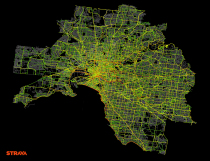 Last month, Strava, which allows users to track their bike rides and runs, launched an interactive map that shows where people move worldwide. That seems to be a lead-in to their larger project Strava Metro. Here's the pitch:
Last month, Strava, which allows users to track their bike rides and runs, launched an interactive map that shows where people move worldwide. That seems to be a lead-in to their larger project Strava Metro. Here's the pitch:
Strava Metro is a data service providing "ground truth" on where people ride and run. Millions of GPS-tracked activities are uploaded to Strava every week from around the globe. In denser metro areas, nearly one-half of these are commutes. These activities create billions of data points that, when aggregated, enable deep analysis and understanding of real-world cycling and pedestrian route preferences.
Strava had a handful of clients before the official launch, such as the Oregon Department of Transportation. From Bike Portland:
Last fall, the agency paid $20,000 for one-year license of a dataset that includes the activities of about 17,700 riders and 400,000 individual bicycle trips totaling 5 million BMT (bicycle miles traveled) logged on Strava in 2013. The Strava bike "traces" are mapped to OpenStreetMap.
This is what I was getting at with those running maps, so it's great to see that Strava was already on it.
It'll be interesting to see where this goes, not just business-wise, but with data sharing, privacy, and how users react to their (anonymized) data being sold.



 Last month, Strava, which allows users to track their bike rides and runs,
Last month, Strava, which allows users to track their bike rides and runs,